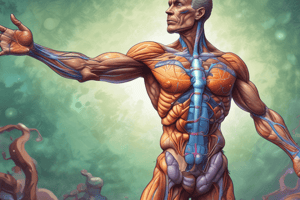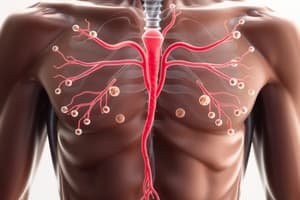Podcast
Questions and Answers
Which of the following accurately describes a neurohormone?
Which of the following accurately describes a neurohormone?
- A chemical secreted by endocrine glands.
- A chemical released by neurons into the blood for action at distant targets. (correct)
- A hormone that uses paracrine signaling.
- A hormone that directly affects the nervous system.
A hormone that binds to receptors on the same cell that secreted it is exhibiting what type of signaling?
A hormone that binds to receptors on the same cell that secreted it is exhibiting what type of signaling?
- Paracrine
- Neurocrine
- Endocrine
- Autocrine (correct)
Why do steroid hormones typically have a longer half-life compared to hydrophilic peptide hormones?
Why do steroid hormones typically have a longer half-life compared to hydrophilic peptide hormones?
- Steroid hormones are inactivated by the kidneys more slowly.
- Steroid hormones are degraded more slowly by the liver.
- Steroid hormones are transported in the blood bound to carrier proteins. (correct)
- Steroid hormones are more easily dissolved in the blood.
What is the primary mechanism by which steroid hormones exert their effects on target cells?
What is the primary mechanism by which steroid hormones exert their effects on target cells?
Which of the following is a characteristic of amine hormones like catecholamines?
Which of the following is a characteristic of amine hormones like catecholamines?
What signaling mechanism is typically associated with hormone receptors located on the plasma membrane?
What signaling mechanism is typically associated with hormone receptors located on the plasma membrane?
How does the cell primarily synthesize and release protein and polypeptide hormones?
How does the cell primarily synthesize and release protein and polypeptide hormones?
What is a key feature of a simple endocrine reflex pathway?
What is a key feature of a simple endocrine reflex pathway?
How are hydrophilic hormones typically transported in the bloodstream, and what effect does this have on their half-life?
How are hydrophilic hormones typically transported in the bloodstream, and what effect does this have on their half-life?
What is a key characteristic of lipophilic hormones in terms of their transport in the bloodstream?
What is a key characteristic of lipophilic hormones in terms of their transport in the bloodstream?
What is the primary role of tropic hormones?
What is the primary role of tropic hormones?
How does the rate of metabolic activation or conversion influence the concentration of a hormone in the plasma?
How does the rate of metabolic activation or conversion influence the concentration of a hormone in the plasma?
Which of the following statements best describes negative feedback control in hormone secretion?
Which of the following statements best describes negative feedback control in hormone secretion?
What is a key characteristic of diurnal or circadian rhythms in hormone secretion?
What is a key characteristic of diurnal or circadian rhythms in hormone secretion?
Thyroid hormone increases the number of receptors for epinephrine in epinephrine's target cells. What is this interaction called?
Thyroid hormone increases the number of receptors for epinephrine in epinephrine's target cells. What is this interaction called?
Which of the following best describes endocrine antagonism?
Which of the following best describes endocrine antagonism?
What is a common cause of endocrine disorders?
What is a common cause of endocrine disorders?
What is the key difference between primary and secondary hyposecretion?
What is the key difference between primary and secondary hyposecretion?
What is a common cause of secondary hypersecretion?
What is a common cause of secondary hypersecretion?
How might mutations in hormone receptors affect hormone action?
How might mutations in hormone receptors affect hormone action?
The hypothalamus communicates with the anterior pituitary via what?
The hypothalamus communicates with the anterior pituitary via what?
Which hormones are synthesized in the hypothalamus and released from the posterior pituitary?
Which hormones are synthesized in the hypothalamus and released from the posterior pituitary?
What is the primary function of vasopressin (ADH)?
What is the primary function of vasopressin (ADH)?
Which of the following is a tropic hormone secreted by the anterior pituitary?
Which of the following is a tropic hormone secreted by the anterior pituitary?
What is permissiveness in the context of hormone interactions?
What is permissiveness in the context of hormone interactions?
How do growth hormone (GH) and insulin-like growth factor-1 (IGF-1) contribute to bone growth?
How do growth hormone (GH) and insulin-like growth factor-1 (IGF-1) contribute to bone growth?
What is the role of thyroid hormone in growth?
What is the role of thyroid hormone in growth?
What are the primary factors that regulate growth hormone (GH) secretion?
What are the primary factors that regulate growth hormone (GH) secretion?
What is the hallmark characteristic of acromegaly?
What is the hallmark characteristic of acromegaly?
Flashcards
Endocrine Glands
Endocrine Glands
Glands that secrete hormones into the blood, which travel to distant target cells.
Hormone
Hormone
A chemical secreted into the blood that travels to a distant target to exert an effect at very low concentrations.
Neurohormone
Neurohormone
Chemicals released by neurons into the blood for action at distant targets.
Paracrine Secretion
Paracrine Secretion
Signup and view all the flashcards
Autocrine Secretion
Autocrine Secretion
Signup and view all the flashcards
Endocrine Secretion
Endocrine Secretion
Signup and view all the flashcards
Steroid Hormones
Steroid Hormones
Signup and view all the flashcards
Amine Hormones
Amine Hormones
Signup and view all the flashcards
Permissiveness
Permissiveness
Signup and view all the flashcards
Synergism
Synergism
Signup and view all the flashcards
Antagonism
Antagonism
Signup and view all the flashcards
Endocrine Disorders
Endocrine Disorders
Signup and view all the flashcards
Primary Hyposecretion
Primary Hyposecretion
Signup and view all the flashcards
Secondary Hyposecretion
Secondary Hyposecretion
Signup and view all the flashcards
Primary Hypersecretion
Primary Hypersecretion
Signup and view all the flashcards
Secondary Hypersecretion
Secondary Hypersecretion
Signup and view all the flashcards
Tropic Hormones
Tropic Hormones
Signup and view all the flashcards
Half-life of Hormones
Half-life of Hormones
Signup and view all the flashcards
Metabolic Activation
Metabolic Activation
Signup and view all the flashcards
Negative-Feedback Control
Negative-Feedback Control
Signup and view all the flashcards
Diurnal (Circadian Rhythms)
Diurnal (Circadian Rhythms)
Signup and view all the flashcards
Posterior Pituitary
Posterior Pituitary
Signup and view all the flashcards
Anterior Pituitary
Anterior Pituitary
Signup and view all the flashcards
Vasopressin (ADH)
Vasopressin (ADH)
Signup and view all the flashcards
Oxytocin
Oxytocin
Signup and view all the flashcards
Tropic Hormones
Tropic Hormones
Signup and view all the flashcards
Somatotropes
Somatotropes
Signup and view all the flashcards
Thyrotropes
Thyrotropes
Signup and view all the flashcards
Corticotropes
Corticotropes
Signup and view all the flashcards
Gonadotropes
Gonadotropes
Signup and view all the flashcards
Study Notes
Chapter 18: The Central Endocrine Glands
- Endocrine glands secrete hormones into the blood, which then travel and bind to specific target cell receptors, triggering a chain of events and leading to the final hormone effect
- A hormone is a chemical secreted into the blood by a cell or group of cells that has effects at very low concentrations, between 10-9M to 10-12M
- Neurohormones are chemicals released by neurons into the blood to act on distant targets
Modes of Hormone Secretion
- Paracrine secretion: hormones affect nearby cells
- Autocrine secretion: hormones bind to receptors on the same cell, affecting that cell
- Endocrine secretion: hormones travel to a distant organ via the blood
Steroid Hormones: Structure and Action
- Steroid hormones: lipophilic and made from cholesterol transported in the plasma by a protein carrier molecule such as corticosteroid-binding globulin or albumin
- Free hormones enter the target cell and mainly bind to cytoplasmic or nuclear receptors, resulting in active DNA for active protein synthesis (genomic response)
- These hormones have longer a half-life (60-90 min), except for aldosterone at 20min
- Small fraction of unbound hormone diffuses into the target cell
- Steroid hormone examples: cortisol, estrogen, and testosterone
- Most cholesterol-containing organs do not produce steroid hormones.
- Most steroids are bound to plasma protein carriers, but unbound hormones can diffuse into the target cell, where steroid hormone receptors are located in the cytoplasm or nucleus.
- The receptor-hormone complex binds to DNA, activating or repressing genes, the activated genes create new mRNA that moves back to the cytoplasm, where translation now produces new proteins for cell processes.
- Some steroid hormones can also bind to membrane receptors, using second messenger systems to create rapid cellular responses
Amine Hormones: Structure and Action
- Made of 1-2 amino acids, mainly tyrosine
- Melatonin is made of tryptophan
- Catecholamines are made of tyrosine
- Thyroid hormones are made of 2 tyrosine and iodine atoms
- Catecholamines (epinephrine, norepinephrine, dopamine) have membrane receptors
- Thyroid hormones have intracellular receptors and exceptions, acting like a steroid hormone
Classification of Hormone Receptors
- Hormones act by binding to receptors.
- A cell's hormone responsiveness depends on its receptors and signal transduction pathways.
- Plasma membrane and seven-transmembrane receptors include ligand types like peptides or catecholamines, using the G-protein/second messenger activating kinase signaling mechanism
- Plasma-membrane with a single-transmembrane include ligand types like growth factors or cytokines, using the kinase cascade signaling mechanism
- Nuclear receptors involve lipophilic hormones like steroids, thyroid hormone, or calcitriol (Vit D3) and bind to DNA and supress/activate gene transcription
Protein and Polypeptide Hormones: Synthesis and Release
- mRNA on the ribosomes of the ER binds amino acids to a peptide chain called a preprohormone and is directed into the ER lumen by a signal sequence.
- Enzymes in the ER chop off the signal sequence, creating an inactive prohormone which passes from the ER through the Golgi apparatus
- The enzymes chop the prohormone into one or more active peptides plus additional peptide fragments
- The secretory vesicles release its contents by exocytosis into the extracellular space where the hormone moves into circulation for transport to its target
Hormone Properties
| Peptide Hormones | Steroid Hormones | Thyroid Hormones | Catecholamines | |
|---|---|---|---|---|
| Solubility | Water | Lipid | Lipid | Water |
| Synthesis | Made/stored/released via exocytosis | Synthesized on demand/simple diffusion | Made in advance/stored in vesicles/released by exocytosis | Made/sotred, released by exo. |
| Transport | Free | Bound to carrier protein | Bound to carrier protein | Free |
| Half-life | Short | Long | Long | Short |
| Receptor | Plasma membrane | Cytoplasm/nucleus | Cytoplasm/nucleus (some plasma membrane) | Plasma membrane |
| Hormone ex. | Insulin, parathyroid hormone | Estrogen, androgen, cortisol | Thyroxine | Epinephrine, norepinephrine |
Review of Control Pathways: Simple Endocrine Reflex
- Stimulus: Increase in plasma [Ca2+]
- Sensor: Parathyroid cells sense the change, release parathyroid hormone
- Target: Kidneys and bone
- Response: Bone reabsorption increases; kidney reabsorption of calcium increases; calcitrol production leads to an increase in intestinal absorption of calcium
Overall Functions of the Endocrine System
- Regulating organic metabolism, H2O, and electrolyte balance
- Inducing adaptive changes to cope with stressful situations
- Promoting smooth, sequential growth and development
- Controlling reproduction
- Regulating red blood cell production
Hormone Categories by Solubility
- Hydrophilic: peptide hormones, catecholamines, indole-amines
- Binds to surface membrane receptors, act through second messenger systems so it alters the activity of pre-existing proteins, like enzymes, so it can produce the desired physiologic response
- Leaves through exocytosis and circulates dissolved in the blood, with a shorter half-life
- Lipophilic Steroid hormones, thyroid hormones
- These hormones activate genes on binding with receptors inside the cell, thus bringing about formation of new proteins, secreted by diffusion and largely bound to plasma proteins"
Responses Regarding Hormone Makeup
- A hormone binding to a membrane receptor consists of peptides and is water-soluble and secreted via exocytosis from an endocrine cell into blood
- Dissolved in the blood not bound to a plasma protein and thus has a shorter half-life
- The second messenger is activated, inducing kinase activation for intracellular change
- Located throughout the body as long as it is connected to blood vessels to detect blood changes
- Lipophilic steroid hormones are made of cholesterol, secrete into the plasma via diffusion, carries by a carrier protein, binds to DNA to transcription with longer half life"
- Hydrophilic peptides and catecholamines
- Have shorter half-life because it is dissolved in the plasma and not bound to a carrier protein in the plasma
- Tight hormone is tightly controlled, but inactivation/excretion is not/regulated
- Clinical implications of patients suffering from liver or kidney are blood pressure and death, or by testing the urine to access endrocine and kidney functions"
Tropic Hormones
- Primary function: regulates hormone secretion by another endocrine gland
- Eg. TSH from the anterior pituitary promotes thyroid hormone secretion by the thyroid gland, maintaining the gland's structural integrity, and in the absence of TSH, the thyroid gland atrophies/shrinks, producing very low levels of these hormones
- Hormone half-life: the time required for half of the hormone concentration to disappear from the blood
Complexity of Endocrine Function
- A single endocrine gland produces multiple hormones -- anterior pituitary releases 6
- A hormone may be is secreted by multiple glands -- Eg. Hypothalamus and Pancreas secreting somatostatin
- A single hormone act act induces multiple effect -- Vasopressin promotes water reabsorption in the kidney by binding with vasoconstriction
- Hormone secretion rates vary -- Eg. the menstrual cycle
- Influence based on target call and number
- Source and messenger either Hormone or Neurotransmitter: the release source is also crucial as messenger
- Some parts specializes function: anterior pituitary, testes and testosterone
Factor Influences on Hormone Plasma Concetration
- Hormone secretion rate by endrocine gland
- Rate of metabolic activation/conversion
- Peripheral modification results in a more active form of the hormone -- thyroxine (T4) to tri-iodothyronine (T3) by the liver and kidneys
- Peripheral hormone action -- testosterone to estrogen
- Lipophillic horomoes
Regulation of Hormone Secretion
-
Solubillity
-
Removal rate (rate) Hydrophylic Hormones Lipophillic steroid Catecholomines (enzyme)
-
Negative-Feedback Control: when the output of a system counteracts a change in input, maintaining a controlled variable around a desired level/set point
-
Neuroendocrine include hormone components and produces a sudden increase in hormone secretion in response to a specific stimulus outside the body
-
Diurnal (circadian) rhythms characterized repetitive oscillations in hormone levels, very regular - cycles every 24 hrs locked on external cues such as the light-dark cycle
Hormone Influence at Target Call
- Permissiveness: One hormone must be present in adequate amounts to permit another hormone to exert its full effect/increase number of receptors
- Synergism: complimentary actions. Combined effect is greater than the sum
- Antagonism: loss the effects of another by loosing receptors from other hormone
Endocrine Disorders
- Disorders most from Abnormal - inappropriate secretion rates, low or high
- Low Responsiveness: abnormally as the the target to hormone is low
- Hyposecretion (too little): occurs when endocrine gland is too little Hormone
- Hypersecretion (too much): abnormality in the gland to tumours
- Tumors ignores controls
Pathologies
- Due to exogenous cortisol
- Iodine difency TRH and T3/T4
Down-Regulation of Hormone Receptors
- Decreases a high source hormone secretion
- Low Responsisveness
Genetic Alteration in Signal Transduction Pathway
- Pseudohypoparathyroidism inherited defect Diagnosis of Pathologies depends on complexity of reflex
Hypothalamus and Pituitary(hypophysis)
Pituitary Gland - Has two distinct lobes, the anterior and posterior pituitary - Posterior pituitary: composed of nervous tissue and called the neurohypophysis - Anterior pituitary: consists of glandular epithelial tissue
Posterior Pituitary
- Posterior pit.t and hypoththalamus make neuroendocrine system
- Simply stores and releases ,vasopressin and oxytocin
- Synthesized and Packaged in and granules Hypothalamus and posterior pituitary
Hormone Control
Vasopressin (ADH) : Conserves water, and arteriole contraction in kidney Oxytocin: During childbirths
Anterior Pitutary: tropic hormones. They regulate the secretion of another specific endocrine gland.
- Somatotropes GH
- Thyrotropes secrete TSH
- Corticotropes ACTH
- Gonadotropes
FSH, regulates development LH, regulate secretion
Non tropic: secrete does directly effects outside of the gland. Secretory : increase breast
GH: somatomodons releasing hormone that TSH, releasing growth hormone hormone. corticotropic hormone gonads
Hypothalamic Releasing and Inhibiting Hormones
- Release and inhibit
- The hypothalamus controls the output of an anterior pituitary hormone
- This is called to the endocrine axis.
- Each 2 factors regulate anterior pituitary hormone:Hypothalamic hormones releasing, Feedback by target-gland hormones.
Hypo-physiothropic Hormones
Vascular link between hypothalamus and anterior pituitary Hypo hormones by neurons , enters into the capillaries Hormones, anterior, hormone into the capillaries And released out
Endrocine Factor Control on Growth
influences factors. Genetic chromic disease. Levels of hormone- Fetal promote, puberty is released Growth: hormone on target
Hormone Metabolic Effects
- increases fatty acid, by breaking down triglycerides
- Increases blood level ,increasing intake
- Amino acid increases.
- Stimulates ammino and protein synthesis stimulates by like growth
Growth Promoting Effects
- Like Insulin IGF by GH Hormones of (Testis or ovaries)
Effect Gh
Promotes tissue, by h.ytrophy GH inhibits a degrad Acid intake promote Increass RNA. DNA. Bones increase
GH hormone stimulates bone
Hormoen Esssential for growth
- Throid - growth,
- Insulin, GH is only
Androgens- synergyistic
- stimulates bone. Ght treated is
Loses
Gith Deficiency
Tumours: dwarfisim or lack
Laron dwar Hormone excess
Gh Stimulatior
By brain tumoutr or GH can cause gigantisim in children. Because, excess Hormone after the period still present
hormone or stimulate hormone, But no tissue can cause issue. GH deficiency, Children, Aids decrease system
Increase system, increased risk Diableis and pressure
Loss body, to stimulate body
- The content contained here is for educational and informational purposes only. Not healthcare advice. Consult professional.*
Studying That Suits You
Use AI to generate personalized quizzes and flashcards to suit your learning preferences.




